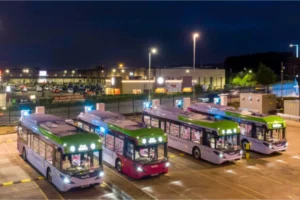The West Midlands region has received £3.85m to fund active travel measures as part of the Department for Transport’s £250m Emergency Active Travel Fund.
Around 45 schemes have been suggested in the West Midlands, including pop-up cycle lanes, wider pavements, and road closures to create low traffic neighbourhoods as well as cycle racks and funds to help cyclists repair and restore old or damaged bikes.
Transport for West Midlands (TfWM) said the government awarded £400,000 more than it asked for, allowing some projects to be accelerated or new schemes added to the list. The extra money is an indication of the strength of the region’s bid, said TfWM, which is part of the West Midlands Combined Authority (WMCA).
The grant forms part of a £40m investment package for cycling and walking in the West Midlands, including the £23m Transforming Cities Fund and £14m due to be awarded in a second tranche of the Emergency Active Travel Fund.
Mayor of the West Midlands Andy Street said: “We have seen a significant shift towards cycling and walking during the coronavirus outbreak, and as we emerge from lockdown we want to provide safe alternatives to car use so that we can maintain both the health and environmental benefits we have clearly seen.”
Birmingham City Council is planning 14 schemes including: a cycle lane in central Birmingham connecting the A38 and A34 blue routes; temporary pop-up cycle lanes on seven priority cycle routes to connect into the city centre; a programme to provide park & cycle options at rail station car parks; low traffic neighbourhoods across Birmingham, created by using bollards or planters to close roads to through-traffic and make walking and cycling safer for local journeys; and the reallocation of road space and pavement widening in two local centres, Stirchley and Moseley – to create space for walking and social distancing.
Coventry City Council, meanwhile, is planning to introduce two pop-up cycle lanes into the city centre, one from the Canal Basin and another from the Health Centre on Stoney Stanton Road.
The routes are due to completed in the next two months, alongside additional social distancing measures on Foleshill Road and road closures within the city centre, said Coventry City Council.
Sandwell Council is planning measures such as one-way systems, cycle lanes, temporary cones, barriers, lines, signs and widening pavements, as well as social distancing signs.
In Wolverhampton, Victoria Street will be partly pedestrianised, from Queen Square to the junction with Bell Street, and paths will be temporarily widened with the use of cones.
Meanwhile, outside of the West Midlands, Brent Council has asked residents to have their say on how it should spend any funding used to support active travel in the borough.
It is consulting on its plans to improve the region’s environment through a series of measures aimed at promoting cycling and walking.
This is likely to include a series of road repairs, pop-up cycle lanes and the continuation of its street widening programme.
Last month, the council confirmed it had bid for £100,000 of funding from the Department for Transport and hoped to secure a ‘portion’ of the £45 million made available to London councils through Transport for London’s Streetspace programme.
According to TfL’s latest tranche of payments, Brent was awarded £125,000 for work on the Harrow Road cycle route between Wembley Triangle and the North Circular Road.
Buckinghamshire is getting over half a million pounds for travel improvements. A further £1.8 million will be used for longer-terms projects as we recover from coronavirus.
Elsewhere, a active travel project through Monkey Island in Lliswerry forms part of Newport city council’s plans to improve the city’s cycling and walking network.
It has also been reported that Norfolk has been given about £100,000 less than ‘disappointed’ council officers thought they would get from the government to make changes to roads to keep people safe during the coronavirus pandemic.
The county had been earmarked to get £1.97m through the governmet’s £225m emergency active travel fund, including almost £400,000 for temporary measures from the phase one pot.
Based on indicative figures, the council bid for £394,000, including to pay for the temporary closures of St Benedicts Street and Exchange Street in Norwich and for alterations on roads in coastal towns and market towns to help people social distance.
In total £37,102,451 of £39,999,000 of phase one cash is now allocated.
Winners from the scheme also include the West of England combined authority-receiving £3.85m, Brighton and Hove UA-£663,657 and Cambridgeshire and Peterboroug-£642,429.





















